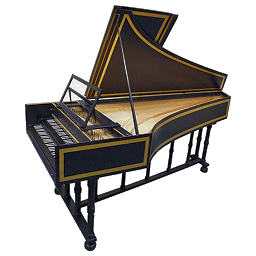Baroque Development
The sonata as known today is a 19th century Romantic development which was literally a couple hundred years in the making. It has become the primary norm in large scale orchestral concert works. William Newton noted this referring to the term 'symphony' as a 'sonata for orchestra' He coined this notion 'the sonata idea.' Though vague, there are references toward the sonata style as early as 1561. Arcangelo Corelli first established the sonata into two classes, the sonata da chiesa and the sonata da camera in the early Baroque period.
The sonata da chiesa was written for one or more violins accompanied by the string bass. It was generally written as a loosely constructed three movement binary form with an allegro, a slow cantible, then a lively finale. With Corelli's efforts, this method of writing sonatas became a mainstay in Italian violin music. The sonata da camera however mostly consisted of prominent dance tunes merging with the style of the sonata da chiesa.
Domenico Scarlatti composed over 500 sonata works mostly in a binary one movement piece in two parts, both sharing the theme and tempo. Scarlatti's work at the time was largely noted for its innovations of harmonious transitions never before heard. During these times, the sonata was primarily an instrumental written most often for harpsichord or other keyboards with or without bass accompaniment. In contrast, nearly half of J.S. Bach's compositions were instrumentals with only 4% being sonatas.
Classical Achievements
During the Classical period, the sonata grew significantly into the mainstream composing styles of concert orchestral compositions. It was now the normal fundamental for the orchestra and more improvements were sure to come. Classical composers tended to strive toward their own styles of writing. Thus, the sonata became multi-movement multi-instrumental works given to other terms like divertimento or partita. The term sonata established its presence further in the compositions of Joseph Haydn who in 1771 was called his first piece a piano sonata. From this point forward, 'diverimento' was a rare reference by composers.
The new movements of the sonata went like this: It began with an allegro developing the theme then a slower second movement in adagio or andante and a third movement back to the allegro style termed the 'finale.' Meanwhile, Haydn was still at it with his two movement sonata into the 1790s. There were also four movement sonatas as seen in further works of Haydn. Wolfgang Mozart tended to keep his sonatas in the three movement form.
In the latter Classical period, more and more composing was leaning toward a four movement form as the primary practice, seen in both symphonies and quartets. The sonata was no exception to the new 'rule' through the works of Ludwig von Beethoven joining the four movement style though he continued the two and three movement sonatas into the 19th century Romantic period. So the four movement style was now the standard for the symphony.
Modern Reference
In four movements, the sonata consisted of an allegro, andante, minuet (a dance), and a finale, often in rondeau style. The role of sonata continued into modern times and arrived as the common reference and practice in writing and performing large orchestra pieces.
Sonata comes from the Italian 'sonate' which literally means "sounding." It is based on the Latin 'sonare' meaning "to sound." The term sonatina refers to a a mini- or 'little sonata.' The term sonata refers to music for instruments as opposed to cantata which refers to music for voice. The sonata now resides alongside the fugue as the most common style of symphonic composing.
Late Classical Sonata
'Piano Sonata No. 14 in C Sharp Minor'
'Mondscheinsonate' "Moonlight Sonata"
Composed by Ludwig Von Beethoven 1801
Early Classical Sonata
'Violin Sonata No. 35 in A major'
Composed by Wolfgang Amadeus Mozart 1787
1720
1787
1801
1828
1862-45
1943
1986
2008
'Piano Sonata No. 14 in C♯ minor' 'Mondscheinsonate' (Moonlight Sonata)
Wolfgang Amadeus Mozart
Ludwig von Beethoven


